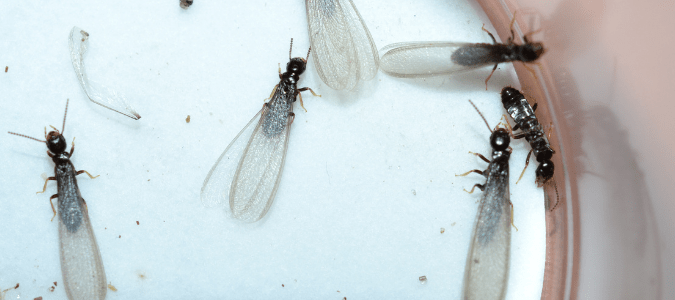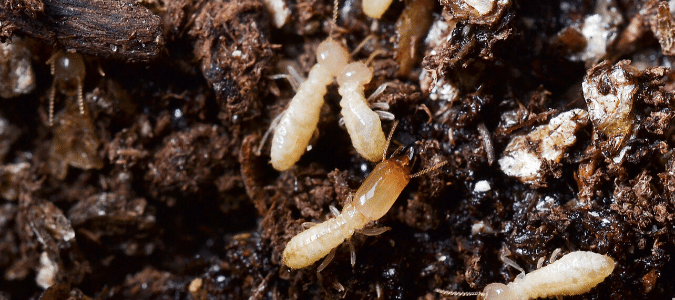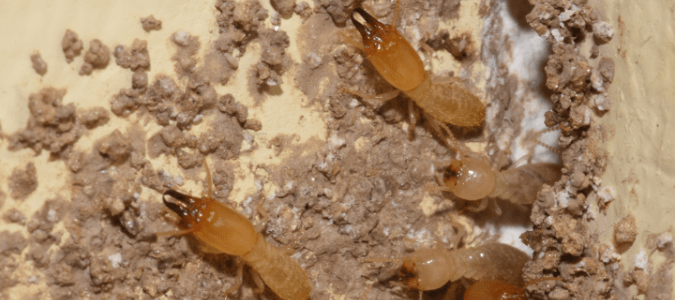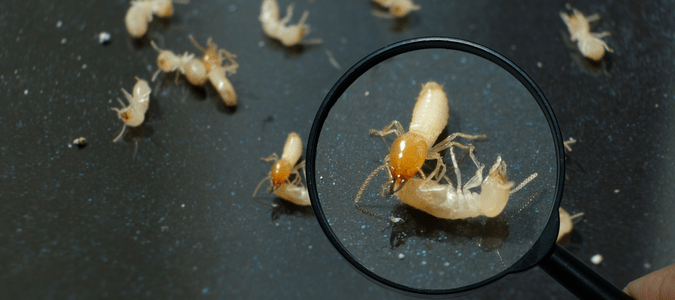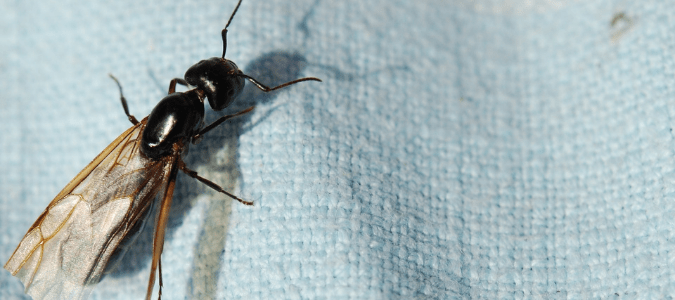The thought of having termites in your home is alarming. These pests can cause damage to your home and it’s difficult to catch an infestation early. When it comes to termites, one common question homeowners have is: What do termites look like?
All termites have a straight waist and straight antennae. Additionally, most species of termites have three different castes—workers, soldiers and reproductives. As their name implies, the workers do the work. They search for food, feed the other castes and maintain and build tunnels and tubes. Soldiers defend the nest against any invaders. Reproductive termites leave the nest when it reaches maturity to create a new colony. Also known as swarmer termites, reproductive termites have wings so they can fly out of the nest when the time is right.
If you are home during a swarm or come home to find shed wings near windowsills, collect a few wings to show a pest control professional. The wings can be a first clue as to what species of termites is in your home.
Different termite species have different identifiers. We will dive into the appearance of common species of termites in the U.S.
Eastern Subterranean Termites
All species of subterranean termites require moisture and live in colonies within the soil. Eastern subterranean termites can vary in color, anywhere from pale cream to black. The worker soldiers are very small, measuring between one-eighth to three-eighths of an inch in length. Soldier termites look very similar to the workers, but they have brown, rectangular-shaped heads with large mandibles. Worker and soldier termite bodies are usually lighter in color and may be white or cream-colored.
The reproductive termites look similar to the other termites, but they have wings and are typically on the larger side. Additionally, their bodies are typically darker, being anywhere from pale yellow-brown to black. Swarmers can range in length from a quarter of an inch to three-eighths of an inch long. Eastern subterranean termite swarmer wings may be pale or smoky gray to brown with distinct vein patterns.
If you have noticed flying termites after rain, you’re most likely dealing with an Eastern subterranean termite infestation.
Drywood Termites
Drywood termites get the moisture they need from the wood they digest, so they don’t need access to soil like subterranean termites. In structures, they prefer to nest under wooden roof shingles, eaves or siding.
Drywood termites measure between a quarter of an inch to a half of an inch long, and they can be cream-colored, light brown, dark brown or black. The drywood termite caste system is different than that of the subterranean termites. Young termites do the work that worker termites typically would do until they reach maturity. Soldier termites measure around a quarter of an inch long. Depending on the species of drywood termite, the soldiers might have dark yellow-brown heads with strong mandibles or have black, square-shaped heads with short mandibles. The workers are smaller than the soldiers and have soft, white bodies.
Drywood swarmers measure in at about a half inch in length. Depending on the species, reproductive drywood termites can be light yellow or dark in color. The wings might be clear or seemingly uncolored, yellow or brown.
Formosan Termites
Formosan termites are actually a type of subterranean termite and they are very aggressive. They are referred to as “super termites” because of their large appetites. It is difficult to differentiate between Formosan workers and other subterranean workers because they are all usually white to off-white in color. Formosan soldiers have tear-dropped or egg-shaped heads, and they are much more aggressive than other worker species. When disturbed, they can exude a small amount of defensive secretion from the front of their head.
Winged Formosan termites are yellowish-brown and about a half-inch in length. Their wings are transparent and have a dense covering of hair. They usually swarm at night in late May or early June and they are attracted to lights.
Typically, the first sign of a termite infestation is a termite swarm. If you have found wings or dead termites on your windowsill, there is a high chance there is an active termite colony on your property. If possible, grab a few wings to show a pest control professional. This can be a first step in determining what kind of termite you have. Depending on the termite you’re dealing with, your professional can create an effective termite treatment plan. They can also speak with you about setting up a recurring termite prevention plan, so you can catch any signs of termites early.
Termites With Wings Versus Ants With Wings
What does it mean if you see black insects with wings? Does this automatically mean you have termites? Not necessarily, you could have carpenter ants. There are a few things you can look at to see if you have termites with wings or ants with wings.
- Antennae: Ants have bent or elbowed antennae, while termites have straight, beaded antennae.
- Wings: Both insects have four wings. Ants have two front wings that are longer than their two hind wings. Termites’ wings are all the same length and are much longer than their body.
- Body shape: Ants have a well-defined, pinched waist. Termites have no defined “waist”.
For additional identification help, you can compare the picture of flying termites at the top of this article to the picture of a flying ant at the top of this section.
Carpenter ants are generally found in logs, stumps or hollow trees. They generally do not bother homes. Carpenter ants are dormant in the winter. It takes about 60 days for a carpenter ant egg to mature into an adult. Carpenter ant tubes are smooth, unlike termite tubes.
Winged carpenter ants are bigger than termites. Their bodies are reddish-brown or black in color and up to a quarter-inch to a half-inch in length. Carpenter ants like moist areas, usually around leaks in the bathtub, sinks or windows.
A carpenter ant infestation can cause damage but nothing like the destruction that a colony of termites can do. Contact a pest control professional to determine what insects are in your home and what treatment is needed.
Should I Knock Down Termite Tubes?
When you come across termite tubes, it likely means termites on your property. If you knock these tubes down, it won’t deter the termites. However, you can use these tubes to your advantage. Crush part of a termite tube and wait a few days. If the tube has been repaired, termites are actively using this tube. If not, it could be an old tube from a previous termite infestation. To be certain you don’t have termites, you can always contact a pest control professional for a thorough inspection.
The tubes that termites create are often called mud tubes, and these little pests use them to get around without being exposed to air. Remember, subterranean termites require moisture to survive, so these mud tubes provide that moisture. They are about the width and color of pencils and can extend for several feet.
Termites use these tunnels as little highways to enter your home, move around and gain access to parts of your home that are edible to get a meal. They can even build tubes from the ground up through a crack in a crawl space.
Termites create these tubes out of materials like soil. When they build these tubes on the outside of a home, they typically build them along the foundation, on a wall or inside a crack. Contact a pest control professional if you see termite tunnels around your property. These tunnels could indicate that a termite colony is nearby.
ABC Can Protect Your Home From Termites
Termites are responsible for costing homeowners billions in property damage each year. If you suspect termites are living on your property, ABC Home & Commercial Services can help. We use scientifically proven methods of termite control to ensure that we eliminate the entire colony. Additionally, we offer ongoing pest management programs, so your property can be less hospitable for unwanted pests.
